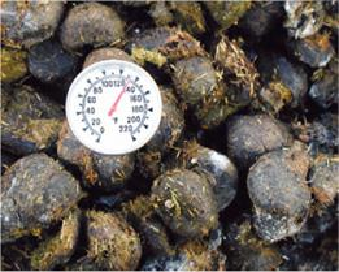Agriculture Reference
In-Depth Information
A section of fence helps contain the pile, and a sprinkler hose laid over the top allows
us to add moisture when necessary.
Decomposition of manure begins with the formation of ammonia as urinary nitrogen de-
composes. The effectiveness of composting depends on the size and shape of the pile, the
degree of compaction, moisture content, and aeration of the manure pile. A large pile with
a flat or concave top is ideal because it retains its own heat and the top captures mois-
ture from precipitation. A small pile with a dome would not hold its own heat as well, and
its rounded top would tend to shed water. A fluffy, occasionally turned pile (for aeration)
makes the best environment for the aerobic composting microorganisms. Aeration can be
accomplished by hand with a fork or with the loader on a tractor. You might turn the pile
three or four times in the first 2 months, then once a month until it's done.
Passive aeration can be attempted by inserting PVC drain tiles into the pile either ho-
rizontally or vertically. These 4-inch-diameter pipes have rows of ½-inch holes drilled in
them. Use 10-foot sections and leave the ends exposed.
A carbon-to-nitrogen (C:N) ratio between 25:1 and 30:1 is optimum for composting. The
lower the C:N ratio, the hotter the compost. Horse manure has a C:N ratio of 30:1 to 50:1.
If you add sawdust (400:1) or straw (80:1) as bedding, the C:N ratio will be higher (cooler).
To keep the C:N ratio in the ideal range, select an amendment with a lower carbon content
or a higher nitrogen content. Grass clippings, at 17:1, make a good addition to lower the
C:N ratio.
Theonlywaytoknowwhetheramanurepileischillyorcookingistotakeitstemper-
ature.

